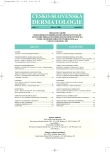Immunophenotypization of Cutaneous T-cell Lymphomas
Authors:
P. Manďáková 1; Kortánková H.t; A. Machovcová 2; V. Campr 1
Authors‘ workplace:
Ústav patologie a molekulární medicíny, UK 2. LF a FN M, Praha, přednosta prof. MUDr. R. Kodet, CSc.
1; Dermatovenerologická klinika UK 2. LF a FN M, Praha, přednostka prof. MUDr. J. Hercogová, CSc. a Dermatovenerologické oddělení, FN M, Praha, prim. MUDr. A. Machovcová
2
Published in:
Čes-slov Derm, 81, 2006, No. 2, p. 82-87
Category:
Clinical and laboratory Research
Overview
Background:
Apart from routine histological and immunohistochemical examination the immunophenotypization by flow cytometry is a very helpful and potent auxiliary method in diagnosis of malignant lymphomas (ML). The first necessary and unevitable step for flow cytometric examination is to obtain a representative cell suspension that can prove to be rather problematic in case of cutaneous T-cell lymphomas.
Methods and results:
In order to isolate lymphoid cells from a skin excision the enzymatic digestion is used. Yet, in case of poor tissue infiltration the flow cytometry fails because of the small amount of lymphocytes in the cell suspension. We have analyzed 66 samples from 17 patients (20 from skin, 20 from bone marrow and 26 from peripheral blood) during primary diagnosis, staging and restaging of cutaneous T-cell lymphoma. The flow cytometry from skin was diagnostic for T-cell lymphoma in 9 cases, in 1 case the finding was suspicious for lymphoma, in 4 cases the examination did not contribute to the diagnosis. In 6 cases the tissue was only sparsely infiltrated by lymphocytes and optimal cell suspension was not obtained. During staging and restaging the examination of the bone marrow samples in 14 cases did not reveal any lymphoma either morphologically or by flow cytometry, in 3 cases the infiltration was proved by both methods. In 3 cases the flow cytometry proved the bone marrow infiltration in spite of a negative histology and in 3 cases the flow cytometric results were suspicious for infiltration while histological finding was negative in 2 cases and unequivocally positive in 1 case. In the peripheral blood samples the tumor cells were detected in 3 cases, the finding was suspicious in 2 cases and negative in 21 cases.
Conclusion:
The flow cytometry is of vital diagnostic importance especially in cases of massive cutaneous infiltration, but lymphoid tissue seems to be a better diagnostic material. If the infiltration of the tissue is not massive, the number of lymphocytes in suspension is insufficient, and the examination is not conclusive. In addition, if the aberrant immunophenotype of tumor cells is observed, the method is ideal for monitoring a minimal residual disease.
Key words:
cutaneous T-cell lymphomas – mycosis fungoides – flow cytometry – Sézary syndrome
Labels
Dermatology & STDs Paediatric dermatology & STDsArticle was published in
Czech-Slovak Dermatology

2006 Issue 2
Most read in this issue
- Cutaneous Pseudolymphomas with B-cell Predominance
- Yellow Nail Syndrome
- Immunophenotypization of Cutaneous T-cell Lymphomas
- Metastasing Cutaneous Malignant Melanoma Treated by Surgery, Radiotherapy and Hyperthermia
